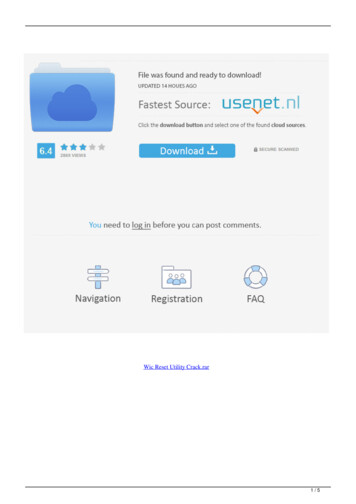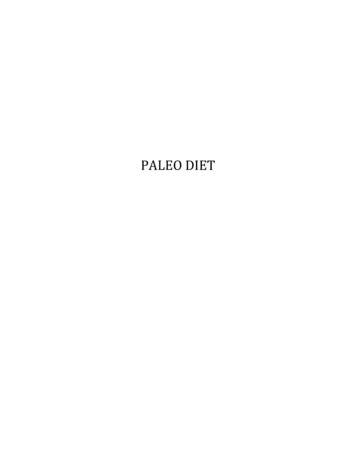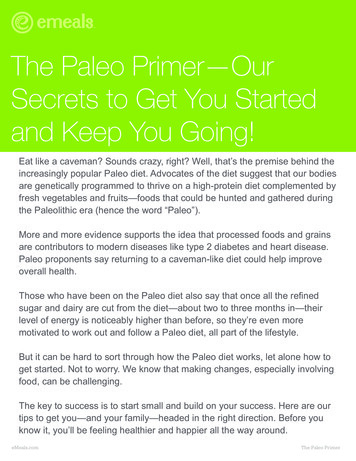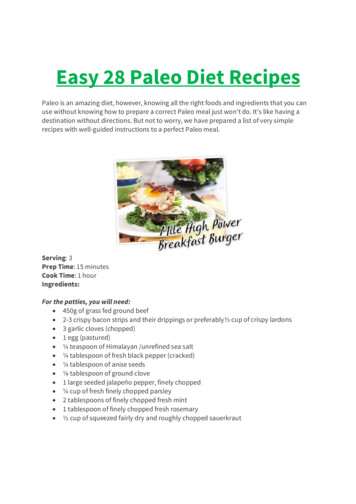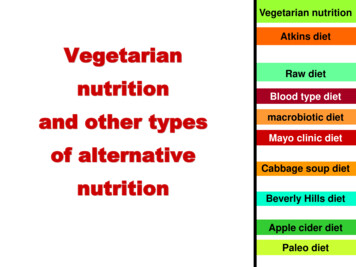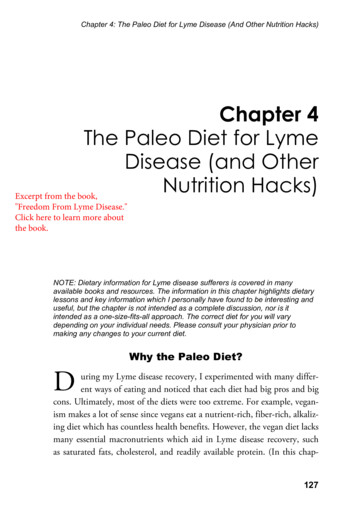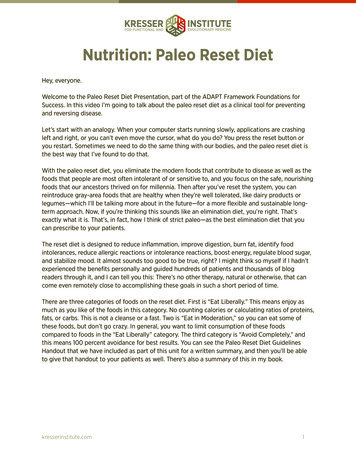
Transcription
Nutrition: Paleo Reset DietHey, everyone.Welcome to the Paleo Reset Diet Presentation, part of the ADAPT Framework Foundations forSuccess. In this video I’m going to talk about the paleo reset diet as a clinical tool for preventingand reversing disease.Let’s start with an analogy. When your computer starts running slowly, applications are crashingleft and right, or you can’t even move the cursor, what do you do? You press the reset button oryou restart. Sometimes we need to do the same thing with our bodies, and the paleo reset diet isthe best way that I’ve found to do that.With the paleo reset diet, you eliminate the modern foods that contribute to disease as well as thefoods that people are most often intolerant of or sensitive to, and you focus on the safe, nourishingfoods that our ancestors thrived on for millennia. Then after you’ve reset the system, you canreintroduce gray-area foods that are healthy when they’re well tolerated, like dairy products orlegumes—which I’ll be talking more about in the future—for a more flexible and sustainable longterm approach. Now, if you’re thinking this sounds like an elimination diet, you’re right. That’sexactly what it is. That’s, in fact, how I think of strict paleo—as the best elimination diet that youcan prescribe to your patients.The reset diet is designed to reduce inflammation, improve digestion, burn fat, identify foodintolerances, reduce allergic reactions or intolerance reactions, boost energy, regulate blood sugar,and stabilize mood. It almost sounds too good to be true, right? I might think so myself if I hadn’texperienced the benefits personally and guided hundreds of patients and thousands of blogreaders through it, and I can tell you this: There’s no other therapy, natural or otherwise, that cancome even remotely close to accomplishing these goals in such a short period of time.There are three categories of foods on the reset diet. First is “Eat Liberally.” This means enjoy asmuch as you like of the foods in this category. No counting calories or calculating ratios of proteins,fats, or carbs. This is not a cleanse or a fast. Two is “Eat in Moderation,” so you can eat some ofthese foods, but don’t go crazy. In general, you want to limit consumption of these foodscompared to foods in the “Eat Liberally” category. The third category is “Avoid Completely,” andthis means 100 percent avoidance for best results. You can see the Paleo Reset Diet GuidelinesHandout that we have included as part of this unit for a written summary, and then you’ll be ableto give that handout to your patients as well. There’s also a summary of this in my book.kresserinstitute.com1
OK, so this is the “Eat Liberally” category. We have meat and poultry, organ meats, bone broth. Oh,before we go on, it’s always preferable to have organic and free-range meat and poultry and organmeats, but it’s especially true during the reset phase, when we’re trying to hit this reset button.Having said that, if your patients can’t afford organic and free-range meat exclusively, don’t let thatstop them from doing this because they’re still going to benefit. Cold-water fatty fish, I recommendthree six-ounce servings a week. If you’re worried about mercury and other toxins, we’re going totalk about that later. Eggs. I hope you’ve gotten the memo by now that there’s really no reason toworry about egg yolks and dietary cholesterol. Even the backward conservative American dietguidelines have now lifted any restriction on dietary cholesterol because there’s simply noevidence that links it to heart disease or any other problem.Then starchy plants, like yams and sweet potatoes, but also plantains, taro, yuca, tapioca, lotusroot. There are really a lot of options here, and a lot of people, when they first start paleo, getreally stuck on sweet potatoes as the only option and they get tired of them, but if you live in acosmopolitan area or any kind of area with ethnic markets, like Asian markets or Latin markets,you’ll be able to find plantains, taro, and yuca, sometimes even at your local grocery store, andthey really help broaden the variety quite a bit.kresserinstitute.com2
Non-starchy veggies, a really wide variety of these. All of them can be eaten either cooked or raw.We have fermented veggies, like sauerkraut, kimchi, curtido, beet kvass, and coconut kefir.Traditional fats, like coconut oil, ghee, red palm oil, macadamia oil, lard, tallow, duck fat, and oliveoil. We have olives, avocados, and coconuts, including coconut milk, and then sea salt and spices.Sea salt has some advantages over table salt, more trace minerals. And then you’d, of course, wantto avoid sugar and artificial flavorings.kresserinstitute.com3
OK, now in the “Eat in Moderation” category, we have processed meat. You want to make sure thatthat’s gluten, sugar, and soy free. Organic and free-range is preferable, of course, but I wouldsuggest limiting it to two to four servings a week. There are several reasons for this. We’ll talkabout it in more detail later. Choose a wide variety of colors of whole fruit. You can have three tofour servings a day, depending on your blood sugar balance. If you have blood sugar issues, youshould probably favor a low-sugar fruit, like berries, grapefruit, and peaches, and limit dried fruits.Then we have nuts and seeds. It’s really easy to overeat nuts and seeds, especially on the resetdiet, so watch out for that. They can also be hard on digestion, especially when they’re eaten raw.A little tip is if you have patients with impaired digestion, have them soak the nuts for 12 to 18hours and then roast them at a low temperature, like 150 or 170 degrees, or dehydrate them beforeeating them, and that will make them a lot easier for them to digest.Then we have green beans and sugar/snap peas. These are not really a problem for most peopleeven though they’re technically legumes. Then coffee and black tea. These are permitted inmoderation, but if you’re experiencing significant fatigue, insomnia, anxiety, mood swings, ordepression, I think it’s best to eliminate caffeine entirely, and it’s good to titrate off of it for two tothree weeks leading up to the reset. Vinegar can be used in small amounts daily as part of dressingor sauces. And restaurant food, you want to limit that because it contains industrial seed oils andhidden ingredients. It can be easy to overeat at restaurants because they do their best to makefood taste as good as possible, and that stimulates reward centers in our brain. Portion sizes areoften out of our control, and so eating at restaurants can be disadvantageous for a number ofreasons.kresserinstitute.com4
The “Avoid Completely” category includes dairy products. I do believe that full-fat and fermenteddairy is healthy when it’s well tolerated by the individual, so that’s something that could bereintroduced later on. Grains, like wheat, rice, oats, pseudograins, etc., these are best avoidedduring the reset and probably best avoided for the most part, with some exceptions, forever. We’llcome back to that as well. Legumes, like beans, peas, lentils, peanuts. Legumes are an area where Idisagree with a lot of other paleo advocates. I think legumes can be a healthy addition to the dietin moderation if they’re well tolerated, as long as they don’t replace other more nutrient-densefoods, and we’ll be talking more about that as well.We have sweeteners, concentrated sweeteners. You should definitely remove those during thereset. This includes sugar, high-fructose corn syrup, but also the natural sweeteners, like coconutsugar, maple syrup, and honey. Those are fine to have in moderation later, but during the reset,they’re best avoided. Then we have chocolate. Dark chocolate is extremely nutrient dense. I’m a bigfan. It has tons of health benefits, but some people are intolerant of the proteins, and I think it’sbest to avoid it during the reset for that reason.kresserinstitute.com5
Then we have processed sauces and seasonings, like soy sauce and tamari. Processed or refinedfoods. As a general rule, if it comes in a bag or a box, you shouldn’t be eating it during the reset. Ofcourse, there are some exceptions. Industrial seed and vegetable oils, like soybean, corn, safflower,sunflower, etc. These are present in restaurant foods, so you won’t be able to avoid themcompletely if you’re eating at restaurants, but you definitely shouldn’t be cooking with them athome or adding them to your foods.Alcohol in any form. There are a number of reasons why I don’t think this should be included in thereset diet. It’s really good for the body to get a break from it for 30 days. Alcohol, unfortunately,can contribute to intestinal permeability if it’s present, so I think it can be really helpful for peopleto just take a 30-day break when they’re doing that reset. Then, of course, sodas and fruit juice,which have very concentrated liquid sweeteners.kresserinstitute.com6
All right, so that’s the basic reset diet, but there are a few variations that you want to be aware of.The first tweak is for patients who are overweight and/or have blood sugar abnormalities. To behonest, the standard paleo reset that I just gave you will often be enough for those patients, andthey don’t necessarily need further modification. Certainly we have several peer-reviewed studiesnow showing that the basic paleo diet is extremely effective for weight loss and also effective fortype 2 diabetes and metabolic syndrome, so this is, to some extent, a clinical judgment call,depending on where your patient is at and what you think they can handle and how significanttheir blood sugar issues are. If they have really significant blood sugar issues and they’re feelinglike they want to be really aggressive, in addition to the reset guidelines that we just talked about,you may also want them to limit starchy vegetables if they know that those aggravate their bloodsugar and further limit fruit beyond what we already talked about.For these kinds of patients, you might advise 10 to 15 percent of calories from carbohydrates.That’s pretty low. Limit starchy vegetables and limit fruit. For the average person, a moderatelyactive male, that amounts to about 65 to 100 grams a day of carbohydrates and about 50 to 75grams per day for a moderately active female.kresserinstitute.com7
The second situation in which you might want to tweak the reset diet is for someone with anautoimmune disease, and again, this is at your discretion. A lot of people with autoimmunity issueswill feel better just moving to a standard paleo reset approach, especially if they’ve been on astandard American diet. Again, if they want to be more aggressive and they’re up for it, you couldadvise, in addition to the basic reset guidelines, avoiding eggs, both egg whites and egg yolks, andnightshade plants, like tomatoes, sweet and hot peppers, eggplant, paprika, cayenne pepper,pepinos, and pimentos, because these foods can, in some cases, but not all, aggravate patientswith autoimmune disease.It’s really important to understand that not everyone with autoimmune disease will need to be onan autoimmune paleo protocol or benefit from it. If your patient does the autoimmune paleoprotocol and removes eggs, removes dairy and even some other foods that some peoplerecommend removing, like nuts, and they don’t notice any difference, and then they add thosefoods back in and they don’t notice any difference, I don’t think it’s necessary for them to continuerestricting those foods. There’s really no peer-reviewed evidence that I’m aware of that suggeststhat people with autoimmune disease should react more to those foods than people that don’thave autoimmune disease. That just mostly comes from anecdotal and clinical experience of agroup of practitioners, so if someone isn’t noticeably reacting to those foods, I don’t think theyshould necessarily remove those for the rest of their life.In a similar way, people that are overweight and have blood sugar issues, as I mentioned, will oftenlose weight and experience improvements without limiting starchy veggies or whole fruit, and ifyou look at the peer-reviewed scientific literature, the studies on the paleo diet did not restrictcarbohydrate intake and permitted starchy vegetable consumption. In fact, the average intake ofcarbohydrates in those studies was close to 30 percent of calories, and yet these people still lostweight and had improvement across the board in their metabolic markers. So if you think it’s goingkresserinstitute.com8
to be a big stretch for your patient to just do the normal paleo reset diet and asking them to dothe autoimmune protocol or the additional restrictions on carbohydrates and fruit is going to beoverwhelming and too much, then just start with the basic paleo approach, and if they’resuccessful, they’ll feel more confident in their ability to add some further restrictions later on.This slide actually still pertains to the autoimmune disease, avoiding eggs and nightshades. Like Isaid, use your judgment in terms of whether to do this at all.Now let’s cover some answers to frequently asked questions. The first is, “When will I see results?”You’ll get that a lot from your patients. The answer is, “It depends,” but in general, the first fewdays can often be pretty hard, as people are kind of going through withdrawal from sugar, coffee,alcohol, etc. Most patients and people I know who have gone through this—including myself wayback in the day—say the first four to seven days are the hardest. After that, people generally starthaving more energy, cravings abate, their skin starts to clear up, their sleep improves, and theirdigestion smooths out.The second question you’ll get a lot is, “Hey, I thought fat’s bad, but a lot of the foods on this diethave a lot of fat in them!” Now, in this case, you can, of course, refer to recent research indicatingthat fat is not the boogeyman we thought it was. My book covers this in detail, so you canrecommend that, and there are many other resources now out there, including articles in majornews outlets, like The New York Times, The Wall Street Journal, etc. In general, I’d counsel you toavoid too much of this kind of discussion, not get into philosophical debates, and just invite themto try it and see how they feel. They’re only committing to 14 days if they do the 14Four or 30 daysif they do the full 30-day reset, and you can tell them they can always go back to a low-fat diet orwhat they were doing before if they don’t feel any better. But I’ve found that, in general, it’s notproductive to get into debates. If you need to do a little of that to convince them to get on boardand try, that’s one thing, but I would just focus on the practical application, and ask them whatthey have to lose. They’re coming to see you for your help, and you’ve been able to help a lot ofpeople with this approach, so just challenge them to give it a try and see how they feel.Another question I get a lot is whether they should count calories or macronutrient ratios. I don’trecommend this. You can explain to your patients that we’re focusing on the quality of nutrientsmore than the quantity and that this is much more important for the vast majority of people. Laterwhen we tweak it further, we may focus more on quantity and mess around with carbohydrateratios, but initially it’s best not to think about counting calories and it’s best not to think aboutmacronutrient ratios.Another typical question is about how to modify this approach for athletes and really activepeople. If they’re seeking to maintain weight or gain muscle, I think they should aim for a muchhigher percentage of calories from carbs than people who are not that active, anywhere from 25 or30 all the way up to 60 percent of calories from carbohydrates for people who are super, superactive and training hard and want to maintain weight or gain muscle. If they’re trying to lose fat, onthe other hand, I would maybe aim for more like 10 to 15 percent of calories from carbohydrates ifthey’re trying to maximize that, especially over a short period of time.kresserinstitute.com9
For protein, most athletes should aim for about 0.8 to 1 gram of protein per pound of bodyweightper day to lose fat or to maintain weight, or 1 to 1.25 grams per pound if they’re trying to gainmuscle. That’s a lot of protein, if you do the math, but it’s been shown to be safe unless they havepre-existing kidney disease, in which case you should be careful and probably recommend a loweramount of protein, but if someone doesn’t have pre-existing kidney disease, those levels of proteinhave been shown to be safe.Finally, a lot of patients will ask if they should continue their supplements during the reset. Thisone’s a little harder to answer because it depends on why they’re taking them, who prescribedthem, etc. If they’re taking them for therapeutic use and they’re getting a known benefit from thesupplement, they should probably continue, but if the patient doesn’t know what the supplementis for, which is often the case—you know, patients will come to you and somebody else prescribeda supplement three years ago and they didn’t even really understand why at the time and they justkept taking it, or maybe they saw something on the internet and they started taking a supplement—if you have a patient on a bunch of supplements like that, I would actually invite them to stoptaking them during the reset.All right, before we finish up, I want to mention some resources that your patients can turn to forsupport. I think the best option for most people at this point is 14Four, which is my diet andlifestyle change program. We’re going to discuss this in a lot of detail later. It has several handoutsdesigned to make the transition to this diet easier, including cheat sheets on fats and oils, pantrycleanout, protein, carbs, fats, paleo superfoods, fermented foods, tips on eating out, tips on eatingpaleo on a budget, etc. It has video demos of me doing exercise techniques and routines that canbe done at home or in an office or in a hotel room. It’s really a great program. It has video andaudio stress management programs and sleep tips, so it covers all the bases for doing acomprehensive reset.There are other options, like doing a full 30-day reset. We’re going to talk about more of theseoptions in the full course and when to use each different one, but for now, you can recommend14Four to your patients, and with some of the cheat sheets and handouts we’re going to give you,you’ll be able to guide them through it yourself.All right, well, that’s it for this presentation. I’ll see you the next time.kresserinstitute.com10
Nutrition: Paleo Reset Diet Hey, everyone. Welcome to the Paleo Reset Diet Presentation, part of the ADAPT Framework Foundations for Success. In this video I’m going to talk about the paleo reset diet as a clinical tool for preve

